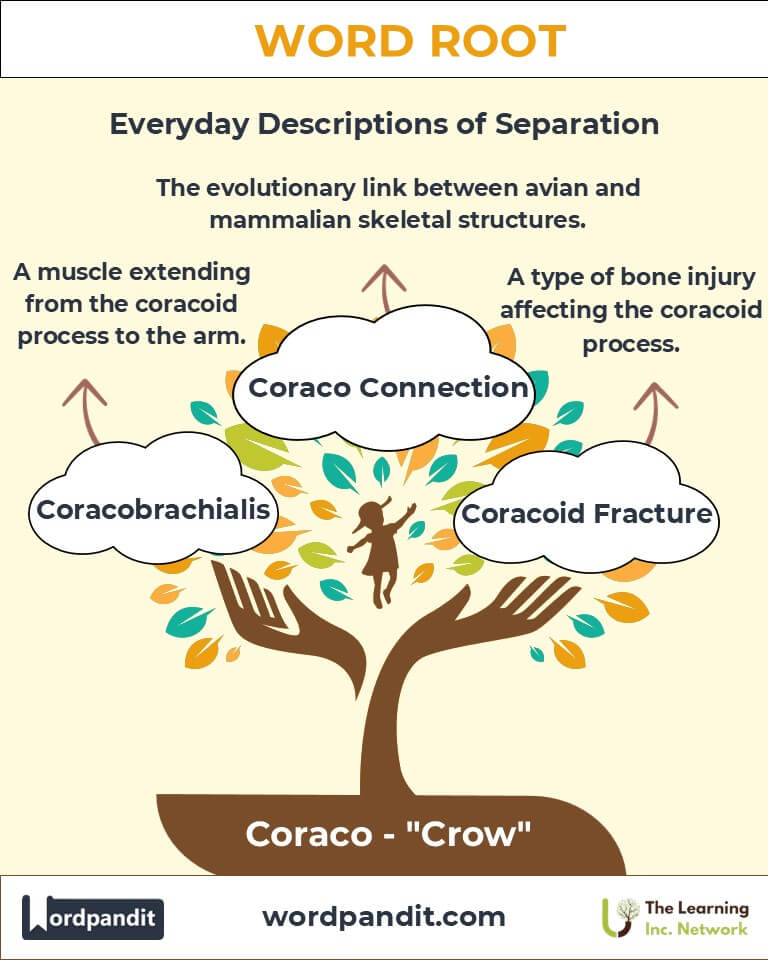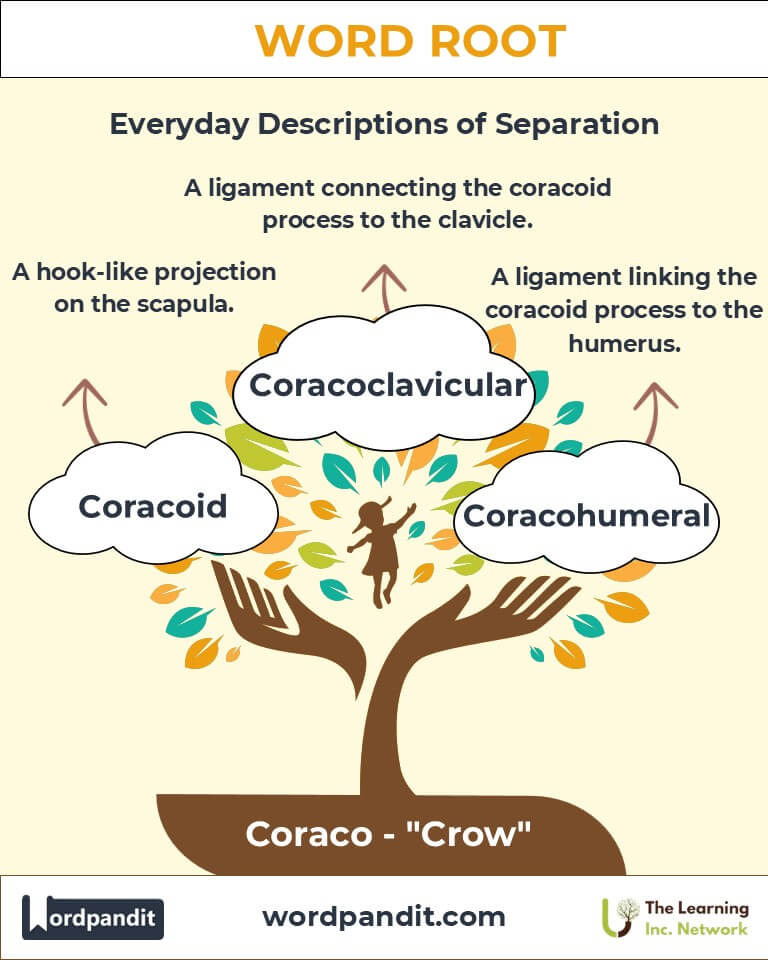Coraco: The Crow Connection in Anatomy and Beyond
Discover the intriguing journey of the root "coraco," originating from the Greek word for "crow." This root highlights anatomical structures resembling a crow's beak and connects diverse disciplines, from ornithology to human anatomy.

Table of Contents
- Introduction: The Essence of "Coraco"
- Etymology and Historical Journey
- Mnemonic: Unlocking the Power of "Coraco"
- Common "Coraco"-Related Terms
- "Coraco" Through Time
- "Coraco" in Specialized Fields
- Illustrative Story: "Coraco" in Action
- Cultural Significance of "Coraco"
- The "Coraco" Family Tree
- FAQs About the "Coraco" Word Root
- Test Your Knowledge: "Coraco" Mastery Quiz
- Conclusion: The Living Legacy of "Coraco"
Introduction: The Essence of "Coraco"
When we think of anatomy, we often consider bones and structures named after their functions or shapes. The root "coraco," derived from the Greek word korax (crow), signifies something shaped like a crow's beak. Pronounced ko-rah-koh, this root is pivotal in naming structures like the coracoid bone, a hook-like projection that bears a resemblance to a crow's beak. Its relevance extends across anatomy, ornithology, and even etymological studies, illustrating its rich history and significance.

Etymology and Historical Journey
The term "coraco" traces back to ancient Greek, where korax (crow) inspired its use. Anatomists in antiquity, observing bird-like shapes in the human skeleton, named the coracoid process after its beak-like resemblance. The term entered modern anatomical lexicons through Latin adaptations, preserving its descriptive origins while enriching its scientific applications.
Mnemonic: Unlocking the Power of "Coraco"
Imagine a crow perched on a branch, its sharp, curved beak glinting in the sunlight. Visualize this beak transforming into the hook-like coracoid process of the human scapula.
Mnemonic Device: "Coraco connects crows and curves, shaping anatomy with avian precision."
Common "Coraco"-Related Terms
- Coracoid (ko-rah-koyd): A hook-like bone projection on the scapula.
Example: "The coracoid process anchors several muscles of the shoulder." - Coracoclavicular (ko-rah-koh-kluh-vik-yuh-ler): A ligament connecting the coracoid process to the clavicle.
Example: "The coracoclavicular ligament stabilizes the shoulder joint." - Coracohumeral (ko-rah-koh-hyoo-mer-uhl): A ligament linking the coracoid process to the humerus.
Example: "The coracohumeral ligament prevents excessive shoulder rotation." - Coracobrachialis (ko-rah-koh-bray-kee-al-iss): A muscle extending from the coracoid process to the arm.
Example: "The coracobrachialis assists in flexing and adducting the arm."
"Coraco" Through Time
Initially used to describe avian anatomy, "coraco" evolved as anatomists adopted its imagery for human structures. The coracoid process, first detailed in ancient texts, became central to understanding shoulder mechanics during the Renaissance, as dissections illuminated its role in muscle and ligament attachment.
"Coraco" in Specialized Fields
- Medicine and Anatomy:
• Coracoclavicular Ligament: Critical for shoulder stability in orthopedic studies.
• Coracoid Fractures: Studied in trauma medicine for their impact on shoulder function. - Ornithology:
• Coracoid Bone in Birds: A key structure enabling wing movement during flight. - Evolutionary Biology:
• Coraco Connection: Highlights evolutionary parallels between avian and mammalian skeletal adaptations.
Illustrative Story: "Coraco" in Action
Dr. Elena Martinez, a sports physician, encountered an athlete with severe shoulder pain after a fall. An X-ray revealed a fractured coracoid process. By understanding the role of the coracoclavicular ligament, Dr. Martinez tailored a rehabilitation plan that restored the athlete’s mobility. Her expertise in "coraco"-related anatomy bridged the gap between diagnosis and recovery, exemplifying the term’s practical importance.
Cultural Significance of "Coraco"
The imagery of the crow’s beak in "coraco" reflects ancient humans' reliance on nature for inspiration. The crow, often symbolic of intelligence and adaptability, aligns with the anatomical function of coracoid structures in providing support and flexibility.

The "Coraco" Family Tree
- Orni- (Bird): Ornithology - The study of birds.
- Brach- (Arm): Brachialis - A muscle involved in elbow flexion.
- Humero- (Upper Arm): Humerus - The bone of the upper arm.

FAQs About the Coraco Word Root
Q: What does the root "coraco" mean?
A: The root "coraco," derived from the Greek word korakos, refers to a crow. In anatomy, it describes structures that resemble the curved shape of a crow’s beak, such as the coracoid process in the shoulder. This term symbolizes how natural forms inspire scientific naming conventions.
Q: What is the coracoid process, and why is it important?
A: The coracoid process is a small, hook-like projection on the scapula (shoulder blade). It serves as a crucial attachment site for muscles (like the coracobrachialis) and ligaments (like the coracoclavicular ligament), stabilizing the shoulder joint and facilitating arm movement.
Q: How does the "coraco" root relate to ligaments and muscles?
A: Structures such as the coracoclavicular ligament and coracobrachialis muscle derive their names from the coracoid process, where they attach. These terms highlight the functional and anatomical relationship between the coracoid and surrounding tissues.
Q: Are "coraco" terms specific to humans, or are they used in other species?
A: "Coraco" terms are used in both human and comparative anatomy. For example, birds have a prominent coracoid bone that supports their flight mechanics, reflecting the evolutionary significance of this structure across species.
Q: What is the coracoclavicular ligament, and what role does it play?
A: The coracoclavicular ligament connects the coracoid process to the clavicle (collarbone). It helps stabilize the shoulder joint, especially during upward arm movements, ensuring the shoulder girdle remains securely aligned.
Q: How has the "coraco" root evolved in scientific usage?
A: Originally describing anatomical structures in humans and birds, "coraco" terms have expanded with advances in comparative anatomy and orthopedics. The root is still rooted in its original Greek meaning but now includes a broader range of functional and evolutionary insights.
Q: What evolutionary significance does the coracoid have?
A: In mammals, the coracoid has become a small process attached to the scapula, while in birds, it remains a distinct bone, critical for the mechanics of flight. This reflects adaptations to differing locomotor needs in evolution.
Test Your Knowledge: Coraco Mastery Quiz
1. What does the root "coraco" signify?
2. Which structure connects the coracoid process and the clavicle?
3. What is the primary function of the coracoid process?
4. In what field is "coraco" most commonly used?
5. How is the coracoid process used in comparative anatomy?

Conclusion: The Living Legacy of "Coraco"
The root "coraco" embodies the intersection of form, function, and imagination. By linking anatomy to the natural world, it enriches our understanding of structural biology and evolution. As we continue exploring its applications, "coraco" reminds us of the enduring relevance of nature-inspired terminology in science and medicine.











